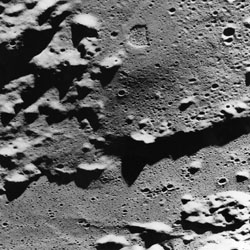julyheader.html

News
Notes
Lunar geology
The
Moon's last gasps
BOSTON
When amateur astronomers 30 years ago trained their telescopes on the
Moon and reported seeing eruptive activity, the consensus from the scientific
community was to lump them into the same group of people who believed “the
face on Mars” was a sign of intelligent life. To suggest the Moon was anything
other than dead did not fit the evidence of the time.
But new evidence garnered from orbiting missions during the 1990s is
changing that status. Don’t write off the Moon as a cold, dead body just
yet. It could still be breathing.
At least four small sections of the crust found in different geologic
areas around the Imbrium basin on the near side of the Moon may be vents
to the deep interior, connected through deep basin faults. The structures
show fine-scale features, details normally lost over time from space weathering,
and other evidence of young age. They may even be a place of active degassing
from the Moon’s interior.

Image data from the Apollo missions of the 1970s revealed unusual structures
on the Moon’s surface. But it took the spectral images taken during the
Clementine mission of 1994 to reinforce their significance. “Clementine
gave us color data and additional information that showed the space weathering
of the features was very little,” says Carlé Pieters of Brown University.
Pieters, along with co-author Mathew Staid of the U.S. Geological Survey,
presented her findings this week during the spring meeting here of the
American Geophysical Union (AGU).
[At right: The Apollo 17 astronauts
took this photograph of the Moon’s Ina feature from the window of the Command
module. As they looked at it through a light filter, it revealed a blue
tint that intrigued them. Recent analysis of Clementine data show that
Ina’s features may be less than a million years old. Photo supplied courtesy
of Peter Schultz, Brown University.]
Within the basin lies the Ina structure, also called the D-caldera after
its shape, which is one structure that is possibly alive and well, says
Peter Schultz, also a Brown University professor and a presenter at the
AGU meeting. In a moonscape where most of the colors astronauts see are
different shades of gray, Ina stands out as a “beacon of blue,” Schultz
says. Through a light filter, this blue jumps out as young, titanium-rich
basalt. As volcanic basalts on the Moon age, they change color and become
less blue, as seen through a 0.415-micron wavelength filter in the visible
light. Or they become redder.
Most of the volcanic eruptions that occurred on the Moon ended 3 billion
years ago, with only some areas on the near side erupting up until 1 billion
years ago. In the Ina area, freshly exposed titanium-rich basalts are found
as blue halos around impact craters. As asteroids and meteoroids strike
the lunar surface, they dig out titanium-rich basalt from underneath.
Ina shows the same titanium-rich basalt, but without any signs of a
lunar impact event — an indication that Ina’s features originated on the
Moon. That does not mean they are the result of a volcanic eruption. Rather,
“it’s a reasonable hypothesis that Ina may have formed by the degassing
of the interior of the Moon,” says Pieters, who also chaired the session
at the Boston meeting. Degassing would bring the basalt to the surface
even without a smashing impact event digging in to expose it.
Still, there’s room for error. Ina is only 2.9 kilometers in diameter
and 30 meters deep. “Something that small does not have much area to accumulate
craters that can be easily counted,” she says. Counting craters is one
way to determine how long an area has been exposed to the space environment,
but smaller targets are harder to hit — making it difficult to determine
their age.
So, for another age test, the geologists turned to a different filter
that looks at iron. Weathering on the Moon’s surface changes the optical
properties of various iron-bearing minerals such as pyroxene and olivine.
The Clementine filter measures the strength of the absorption band in the
one-micron wavelength, just beyond the visible in the near infrared. Ina’s
strong absorption in the ferrous (Fe2+) band in pyroxene indicates
its rocks have had little exposure to the pelting of micrometeorites from
space, which would weaken its absorption capabilities. “The ferrous band
of Ina is as strong as that of a fresh crater in basalt,” Pieters says.
But, unlike the craters, Ina also shows different morphological features
that are sharp structures, devoid of the rounding that occurs over time.
“Whatever formed the feature happened relatively recently,” Pieters says.
Ina looks younger than the 50- million-year-old North Ray crater but has
an appearance comparable to the 2-million-year-old South Ray crater, Schultz
says.
The idea that Ina-like features on the Moon could be active vents follows
a presentation at the Lunar Planetary Science Conference in March, when
scientists reported finding radon gas in data still being analyzed from
the Lunar Prospector that circled the Moon for a year and a half beginning
in 1998, says Bill Feldman of Los Alamos National Laboratory. Radon gas
is a product of iridium decay and is visible for only three to four days
before it decays into alpha particles. If the data were correct, radon
was actively degassing while the Lunar Prospector passed over the Moon.
“It would be interesting to look at the Ina feature to see if it’s still
venting,” Feldman says.
“Is the Moon alive?” asks Schultz. “It’s not erupting. But what we are
seeing are its last gasps. So in that sense: Yes, it is.”
Christina Reed


